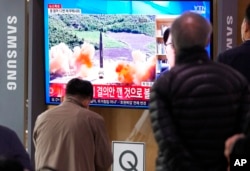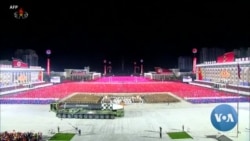Experts say the missile North Korea launched on Thursday involved a full flight test of an intercontinental ballistic missile (ICBM) with the potential for carrying multiple nuclear warheads and capable of targeting any location in the United States.
Jeffrey Lewis, director of the East Asia Nonproliferation Project at the Middlebury Institute of International Studies at Monterey, California, said North Korea is trying to demonstrate that it has "the ability to place multiple nuclear warheads [and hit] targets anywhere in the United States."
North Korea announced through its official Korean Central News Agency on Friday that its leader Kim Jong Un had ordered the launch of Hwasong-17 ICBM that flew 1,090 km and reached an altitude of 6,248 km, according to the Yonhap News Agency in South Korea.
The launch was Pyongyang's 11th missile test of the year including one that failed on March 16. The test on Thursday officially ends a moratorium Pyongyang had adopted for itself in 2018 on testing a long-range ballistic missile.
Lewis said if the ICBM North Korea tested is in fact a Hwasong-17, it could potentially carry multiple nuclear warheads.
U.S. President Joe Biden met with Japanese Prime Minister Fumio Kishida in Brussels on the sidelines of the G-7 meeting on the Ukraine crisis on Thursday and discussed North Korea's ICBM test. The two agreed to continue to work together to hold North Korea accountable. The Biden administration has been looking toward Toyko and Seoul to forge trilateral cooperation for dealing with Pyongyang.
Through a statement released on Thursday, White House press secretary Jen Psaki said, "The United States will take all necessary measures to ensure the security of the American homeland and Republic of Korea and Japanese allies."
VOA's Korean Service contacted the North Korean mission at the U.N. but did not receive a reply.
Most powerful ICBM to date
Experts said the launch was a full flight test of an ICBM unlike the tests North Korea conducted on February 27 and March 4, which the U.S. has said did not demonstrate a full ICBM range.
"Based on the flight time and altitude, this was definitely a full test of an ICBM system," said Ian Williams, deputy director of the Missile Defense Project at the Center for Strategic and International Studies.
The ICBM traveled higher and farther than the previous record-setter, the Hwasong-15, tested in November 2017, according to Bruce Bechtol, a former intelligence officer at the U.S. Defense Intelligence Agency and now a professor at Angelo State University in Texas.
"Based on mathematics of how high this missile flew and how long it flew … this [ICBM] could reach the entire mainland of the U.S.," Bechtol said.
The missile launched on Thursday peaked at 6,000 km in altitude and traveled 1,100 km in distance, according to an assessment by Japan's Defense Ministry.
In comparison, the Hwasong-15 North Korea launched in November 2017 reached about 4,500 km at its highest altitude and 960 km in distance.
Bechtol said the Hwasong-15 tested in 2017 also showed the capability of reaching the entire U.S. mainland although it did not fly as high or as far as the ICBM tested on Thursday.
Lewis said the altitude and the distance that the missile traveled on Thursday indicated that it could cover a range of about 12,000 km if traveling on a trajectory aimed to hit a target and "can definitely cover the entire U.S."
Remaining hurdles
Experts said the ICBM appears capable of carrying multiple nuclear warheads, but whether it could deliver the warheads on a flight path over the U.S. remains to be seen.
Bruce Bennett, an adjunct defense researcher at the Rand Corporation, said the ICBM "could carry multiple nuclear warheads." He continued, "The question is how far could it carry them?"
Bennett said North Korea has not demonstrated capabilities that it could deliver a nuclear warhead on an ICBM traveling on a trajectory that would fly over the U.S. atmosphere without the warhead burning up.
North Korea tests missiles by launching them into the atmosphere at a steep angle so they can travel on a so-called "lofted trajectory." Williams said so far, North Korea "has only tested ICBMs on lofted trajectories."
If North Korea shoots an ICBM on a non-lofted trajectory, Williams added, the missile will travel through more atmosphere, which would force a warhead on the ICBM to endure more heat stress than if it were traveling on a lofted trajectory.
A reentry vehicle carrying a nuclear warhead might not survive a non-lofted trajectory as it returns to Earth, Williams continued.
"North Korea has not yet fully demonstrated that its warheads can survive reentry under realistic conditions," Williams said. "This is, in my mind, the last piece of the puzzle that would remove all doubts that North Korea has developed a functional ICBM capable of delivering a warhead."


















